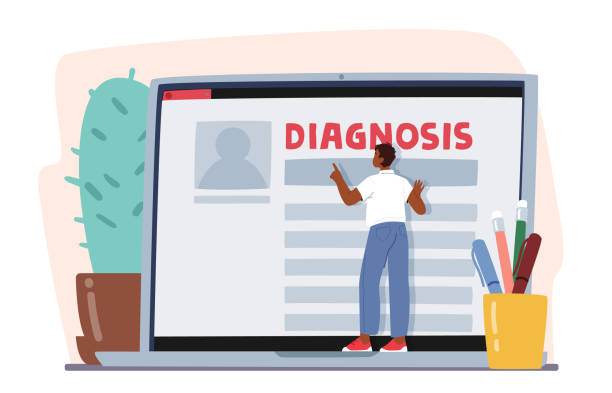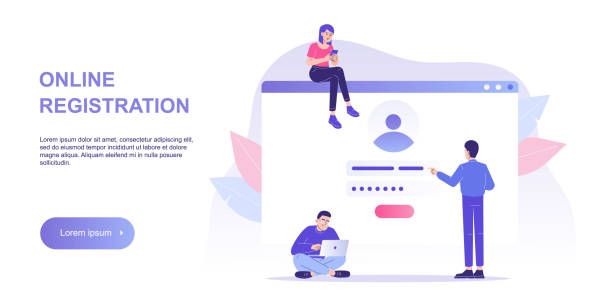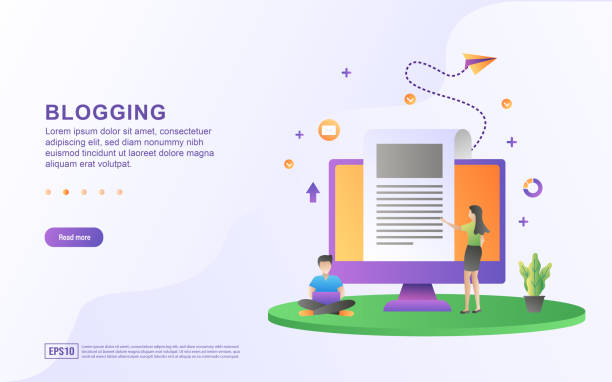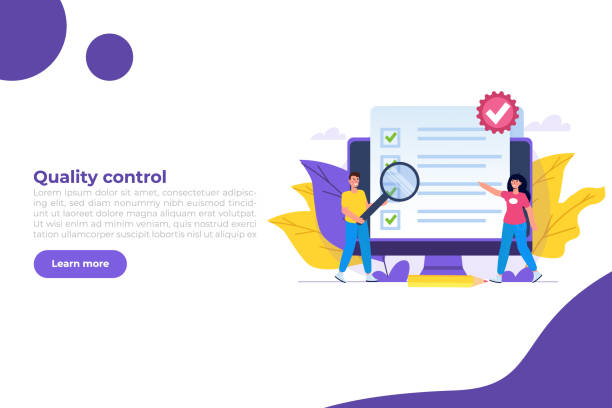Introduction to User-Friendly Website Design: Its Importance and Necessity

In today’s digital world, #user-friendly website design is no longer an option, but a vital necessity.
A website that can meet users’ needs intuitively, easily, and pleasantly not only retains visitors but also converts them into loyal customers.
The importance of user-centric website design goes beyond mere aesthetics; this approach focuses on the overall user experience from the moment they enter the site until they reach their ultimate goal.
A user-friendly site is one that #loads quickly, has #easy and logical navigation, and whose content is easily understandable and accessible.
This is especially critical for businesses, as it directly impacts the conversion rate of visitors into customers and, ultimately, the Return on Investment (ROI).
A poorly designed site can quickly frustrate users and drive them to competitors who offer a better experience.
Therefore, focusing on creating an exceptional User Experience (UX) is considered the cornerstone of online success.
This educational approach helps you gain a deeper understanding of the various dimensions of designing a functional and effective website and enables you to take practical steps to improve your own website.
Do you have an online store, but your sales aren’t as expected? RasaWeb solves your problem forever with professional e-commerce website design!
✅ Significant increase in conversion rate and sales
✅ Unparalleled user experience for your customers
⚡ Click to get a free consultation with RasaWeb!
Key Principles of User-Friendly Website Design: Pillars of a Successful User Experience

To achieve a truly user-friendly website design, a set of principles and rules must be observed that form the main pillars of a successful user experience.
The first principle is “Usability”; meaning users can perform their tasks on the site without confusion and with minimal effort.
This includes clear navigation, simple forms, and understandable information.
The second principle is “Accessibility,” which ensures the site is usable for everyone, including people with disabilities.
This involves using appropriate tags for images, suitable color contrast, and keyboard-friendly design.
The third principle is “Responsiveness”; meaning the site should display correctly on all devices, from mobile phones and tablets to laptops and desktops, providing a consistent user experience.
This analytical approach shows how implementing these principles can significantly improve user satisfaction and, consequently, increase conversion rates.
Without adhering to these principles, even the best content may go unnoticed, and your efforts may be fruitless.
Understanding Users: A Fundamental Step in User-Friendly Website Design

Before starting any design, the essential and vital step is a precise understanding of the target audience.
This specialized phase allows you to comprehend your users’ needs, desires, behaviors, and even pain points.
Creating “User Personas” is one of the best methods for this purpose.
A user persona is a fictional character, based on real data, that represents a specific group of your users.
These personas include information such as age, occupation, education level, goals, motivations, challenges, and even online habits.
With this deep understanding, the design can be tailored to perfectly align with the needs of this user group and provide the necessary guidance for their navigation.
This approach literally lays the foundation for a user-friendly website design, as all design decisions are made based on credible information, not assumptions.
A correct understanding of the user leads to more intuitive navigation, more relevant content, and ultimately, a more enjoyable experience.
| Research Method | Description | Application in User-Friendly Design |
|---|---|---|
| User Interviews | Direct conversations with users to understand their needs and opinions. | Creating accurate personas, uncovering hidden needs. |
| Surveys and Questionnaires | Collecting quantitative data from a large number of users. | Identifying behavioral patterns and general preferences. |
| Statistical Data Analysis (Analytics) | Analyzing website traffic data (Google Analytics) to understand user behavior. | Identifying highly visited pages, bounce rates, common user paths. |
| Usability Testing | Observing users as they perform specific tasks on the site. | Identifying weaknesses in navigation and user flow. |
| Card Sorting | Users are asked to categorize concepts into logical groups. | Improving information architecture and menu structure. |
Information Architecture and Navigation: The Main Arteries of User-Friendly Website Design

Information Architecture (IA) and Navigation are two fundamental pillars in user-friendly website design that help users effortlessly find their way through a wealth of information.
A strong information architecture organizes website content in a way that is logical, predictable, and hierarchical.
This organization includes content categorization, clear labeling, and creating a logical structure that allows users to quickly access what they need.
Navigation refers to the menu systems, links, and buttons that guide the user from one point to another on the site.
Navigation should be intuitive, consistent, and always accessible.
Using breadcrumbs, internal search, and sitemaps are among the solutions that help improve navigation.
This educational and guiding aspect is crucial because even the best content will be useless if it is not accessible.
Proper implementation of these elements significantly improves the user experience and encourages users to spend more time on the site.
Did you know that 85% of customers check your company’s website before any interaction?
With RasaWeb, build a corporate website worthy of your reputation.
✅ Increased credibility and customer trust
✅ Attraction of high-quality leads
⚡ Get a free website design consultation
Visual Elements and User Interface (UI) Design: Beauty Serving Functionality

Alongside technical and structural principles, visual elements and User Interface (UI) design play a very important role in the attractiveness and effectiveness of user-friendly website design.
UI goes beyond mere aesthetics; this section deals with how the user interacts with the site and includes the design of buttons, forms, typography, color palette, and the overall layout of pages.
A good user interface should be visually appealing but, at the same time, clearly indicate the function of each element.
Proper use of whitespace, clear visual hierarchy, and optimal color contrast all contribute to improving readability and guiding the user’s eye.
This explanatory approach demonstrates how colors, fonts, and images can influence users’ emotions and behavior.
For example, soothing colors can evoke a sense of trust, while readable fonts improve the reading experience.
The ultimate goal is for UI design to not only be beautiful but also help users easily achieve their goals and have a pleasant experience.
This harmony between beauty and functionality makes your site memorable in the minds of users.
Common Mistakes in User-Friendly Website Design and Solutions to Avoid Them

Even experienced designers can fall into the trap of common mistakes in user-friendly website design.
Awareness of these errors and solutions to avoid them is one of the questionable but very useful aspects of the content.
One of the biggest mistakes is neglecting usability testing.
Many designers assume their design is intuitive, but only by observing real users can weaknesses be discovered.
Another mistake is excessive complexity in navigation or forms.
Users seek simplicity, and long forms or cluttered menus can drive them away.
Lack of mobile optimization is also a glaring error in today’s world, as a large portion of web traffic comes from mobile devices.
Furthermore, slow page loading speeds can severely harm the user experience and increase bounce rates.
Ignoring accessibility for people with disabilities is not only a design mistake but can also have legal consequences.
By learning from these mistakes and implementing correct solutions such as simplification, performance optimization, and continuous testing, an excellent user experience can be effectively guaranteed.
Continuous Testing and Evaluation: Ensuring a Dynamic User-Friendly Website Design

The process of user-friendly website design does not end after the initial launch; instead, it requires continuous testing and evaluation.
This specialized and informative approach helps you to always be improving and optimizing.
Usability testing can be done through various methods, including A/B testing, five-second tests, and eye-tracking.
These tests provide you with valuable data to understand how users interact with your site, where they encounter problems, and what they like.
The results of these tests should form the basis for decisions regarding future updates and changes.
Furthermore, analyzing website statistical data (such as bounce rate, time on page, user paths) can provide deep insights into user behavior.
This continuous feedback allows you to constantly align the site with changing user needs and expectations, ensuring their experience is always at its highest level.
Do not forget that a user-friendly website design is a living entity that incorporates new information with every user interaction and evolves.
| Test Method | Advantages | Disadvantages |
|---|---|---|
| A/B Testing | Accurate in comparing two versions, reliable quantitative data. | Only for small changes, cannot explain “why”. |
| Moderated Usability Testing | Deep insights into user behavior, possibility of Q&A. | Time-consuming and costly, requires a skilled facilitator. |
| Unmoderated Usability Testing | Scalable, cheaper, possibility of remote testing. | Lack of deep insights, no immediate Q&A. |
| Heatmaps | Visual display of user clicks and scrolls, easy to understand. | Only shows “where” clicked, not “why”. |
Psychology in User-Friendly Website Design: Engaging User Emotions

One of the most fascinating aspects of user-friendly website design is understanding and applying psychological principles in design.
This entertaining yet informative approach helps you not only meet users’ rational needs but also connect with their emotions.
The “Peak-End Rule” suggests that users remember an experience based on its emotional peak (good or bad) and how it ended.
Therefore, focusing on creating enjoyable moments and satisfying endings along the user journey is of high importance.
The “Von Restorff Effect” states that distinct and salient elements are better remembered.
This principle can be used to highlight Calls to Action or key information.
Furthermore, the concept of “Cognitive Load Theory” implies that excessive information should be avoided to keep the user experience simple and unambiguous.
Using appropriate colors, captivating images, and even subtle animations can help create a positive emotional experience.
The ultimate goal is for users not only to find your site useful but also to enjoy using it and feel good about it, which leads to their return.
Are you worried about losing customers because you don’t have a professional e-commerce website?
With e-commerce website design by RasaWeb, forget these worries!
✅ Significant increase in sales and visitor-to-customer conversion rate
✅ Professional and user-friendly design that builds customer trust
⚡ Get a free consultation from RasaWeb
The Future of User-Friendly Website Design: Emerging Trends and New Technologies

The world of user-friendly website design is constantly evolving, and awareness of emerging trends and new technologies is of particular importance.
This analytical aspect helps you look into the future.
One of the most important trends is Responsive Design, which has always been important but its significance has grown with the increasing diversity of devices.
Artificial Intelligence (AI) and Machine Learning (ML) are changing how users interact with websites; from smart chatbots and voice assistants to content personalization based on user behavior.
Augmented Reality (AR) and Virtual Reality (VR) also have great potential to create immersive and engaging experiences, especially in areas like e-commerce and education.
Additionally, attention to voice-centric design (Voice UI) and screenless user interfaces (Conversational UI) is increasing.
These changes indicate that website design with a user-friendly approach must constantly adapt to new technologies and user expectations to remain relevant and effective.
The Role of Content in User-Friendly Website Design: Content That Retains Users
![]()
Content is one of the most important components of a user-friendly website design.
Even the best design and navigation structure cannot save weak content.
This section focuses on the importance of content.
Website content must be relevant, accurate, up-to-date, and understandable.
Using simple and fluid language, avoiding complex technical jargon (unless the target audience is specialists), and organizing content into short paragraphs, lists, and subheadings all contribute to improving readability.
Visual content such as high-quality images, videos, and infographics can also enhance attractiveness and better comprehension of the material.
Calls to Action (CTAs) should be clear and persuasive to guide users to the next step.
Optimizing content for Search Engines (SEO) is also crucial so that users can easily find your site.
Ultimately, content that meets users’ needs and answers their questions is considered valuable and will lead to an increase in their time spent and engagement with the site.
Strong content is the beating heart of a user-friendly site.
Frequently Asked Questions
And other advertising services of RasaWeb Advertising Agency
- Intelligent Customer Journey Map: A fast and efficient solution for increasing website traffic with a focus on SEO-driven content strategy.
- Intelligent Content Strategy: A professional solution for digital branding focusing on customizing the user experience.
- Intelligent Direct Marketing: Designed for businesses seeking digital branding through user experience customization.
- Intelligent Data Analysis: Designed for businesses seeking customer behavior analysis through Google Ads management.
- Intelligent Content Strategy: Designed for businesses seeking campaign management through attractive UI design.
And more than hundreds of other services in the field of internet advertising, advertising consulting, and organizational solutions
Internet Advertising | Advertising Strategy | Advertorials
Resources
Principles of User Interface and User Experience DesignWhat are UI and UX?What is Website User Experience and How to Improve It?Website Design Principles for Success in Digital Marketing
? For the growth and visibility of your business in the online space, RasaWeb Afarin Digital Marketing Agency is with you, providing comprehensive and specialized services. Among our services is corporate website design in accordance with the latest world standards.
📍 Tehran, Mirdamad Street, next to Central Bank, Southern Kazeroun Alley, Ramin Alley, No. 6
